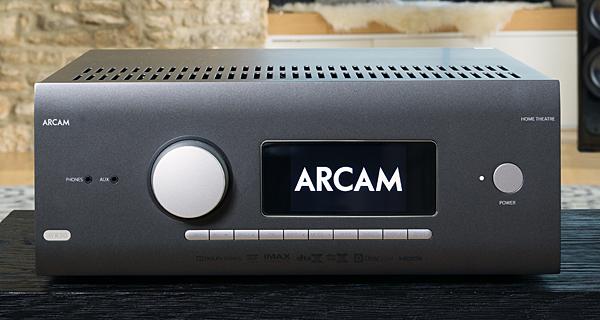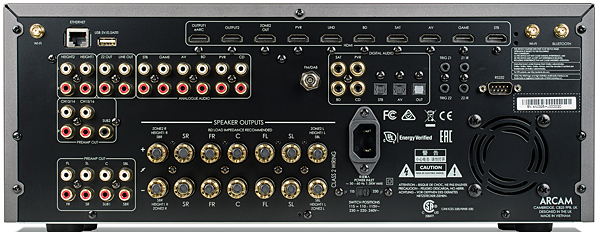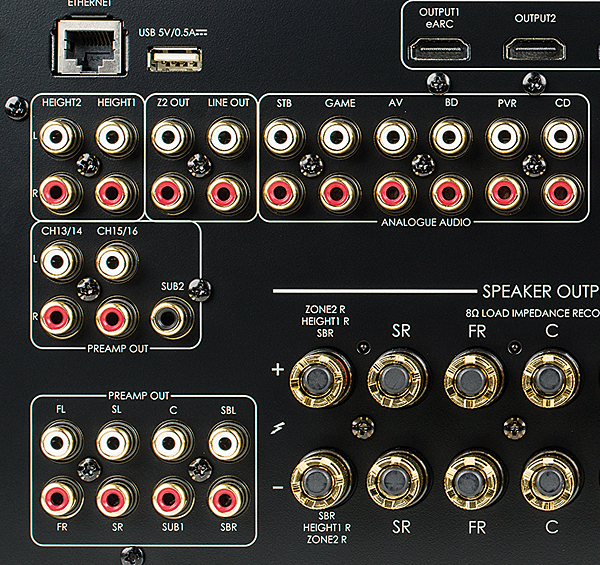Arcam AVR30 AV receiver review

 Steve Withers swaps FMJ for HDA and finally turns into an object-based nutter as he immerses himself in 16 channels
Steve Withers swaps FMJ for HDA and finally turns into an object-based nutter as he immerses himself in 16 channels
Arcam's new lineup of AV models is finally here, adding three seven-channel receivers and a 16-channel processor to its High Definition Audio (HDA) range. HDA, for those who keep an eye on acronyms, replaces the outgoing, and cooler named, Full Metal Jacket (FMJ) series, bringing with it a number of changes – some more apparent than others.
The most obvious difference is cosmetic, with a 'lifestyle-friendly' design replacing the more traditional – and some would say 'industrial' – Arcam look. To be honest, the two-tone styling of the silver buttons and volume dial looks a bit odd on a high-cost receiver, so the redesign might not be a complete success. On the plus side, a full-colour LCD screen replaces the previous green dot-matrix display, and only die-hard retro freaks will lament its passing.
Aesthetics aside, the real differences are internal, with the new models supporting Dolby Atmos, DTS:X, IMAX Enhanced and Auro-3D right out of the box – with the latter being new to Arcam. While the receivers are limited to seven channels of built-in amplification, the processing can handle up to 16, which means Atmos at 15.1 and Auro-3D at 13.1, although Arcam's implementation of DTS:X is still limited to 11.1 channels.
The other big change is evidenced by three huge antennae at the rear: the HDA lineup sports built-in Bluetooth and Wi-Fi, with support for Google Chromecast and Apple AirPlay 2. So no more tripping over Ethernet cables just to stream content, run Dirac Live or update the firmware.
In terms of other new features, the receivers and processor still have a 7-in, 3-out HDMI stage with 4K HDR passthrough, but now add support for eARC, allowing lossless audio to be sent back from a compatible TV. The continued use of HDMI 2.0b – rather than 2.1 – does limit future-proofing, but Arcam has never been a brand to ring all bells and whistles.
Good Things Come In Threes
The AVR30 reviewed here is the flagship HDA receiver (£5,000). Along with the features already mentioned, it packs ESS 9026PRO audiophile DACs, Class G amplification with a toroidal transformer, and Dirac Live room correction.

The second-tier AVR20 (£3,000) is essentially the same but switches the more expensive Class G for traditional Class AB amplification. If you don't need 16 channels of processing there's the entry-level AVR10 (£2,400), which also uses Class AB amps but is limited to 7.1.4 decoding on all formats. The AV40, meanwhile, is a 16-channel processor (£3,800) that swaps the AVR30's onboard power for balanced XLR outputs.
You might wonder why the AVR30 only has seven powered channels but can decode up to 16. Arcam believes it's better to offer high-quality Class G grunt, rather than compromise performance by cramming in more amp modules. For those wanting extra channels, the company sells its PA410 power amp with four channels of Class AB, or the PA720 with seven channels of Class G welly.
Arcam has been using Class G on some of its amps since 2009. Intended to ape the efficiency and low power consumption of Class D, without sacrificing audio quality, it uses a conventional output stage fed from two (or more) power supplies that are introduced according to signal demand; the higher PSU rail(s) are only switched in once the audio output rises above a certain level.
An Arcam AVR850 previously graced my reference system, so I'm familiar with the AVR30's immediate predecessor and, cosmetics and processing aside, the two aren't wildly different.

The built-in Wi-Fi is very welcome. It's a cinch to connect using Chromecast or AirPlay, and makes streaming music painless. It's also useful for setup because surprisingly the new model doesn't have an onscreen menu – you can either use the LCD display on the unit itself, or a web-based interface. The only onscreen info relates to changes in volume or the selected source.
The remote control remains the same, and that includes the annoying quirk where you have to remember to press the 'Amp' button after selecting an input. You also still can't reassign the internal amplification, although you do have greater flexibility with the outputs for channels 13 to 16. These can be assigned for front width, extra height or additional subwoofer channels.
The receiver is supplied with a calibrated microphone and supports the latest version of Dirac Live, allowing you to measure the speakers in your system and correct for your room's acoustic aberrations. You can customise the target correction filters, group speakers together to create system-wide crossovers, and create up to three profiles for different content or room conditions. It's impressively flexible, and its impact can be considerable.
Pushing The Envelope
For full immersion I used a 9.2.6 system based around M&K Sound speakers and subs, with an Emotiva XPA-11 power amp to drive the additional eight channels. And it was fantastic...
Regardless of your chosen speaker configuration this receiver is capable of a clean yet powerful delivery. The soundstage is balanced, with all the energy, poise and responsiveness I have come to expect from Class G. The dynamic range is also phenomenal, going from kitten's breath to eardrum-shattering in an instant.
 |
Home Cinema Choice #351 is on sale now, featuring: Samsung S95D flagship OLED TV; Ascendo loudspeakers; Pioneer VSA-LX805 AV receiver; UST projector roundup; 2024’s summer movies; Conan 4K; and more
|






















































